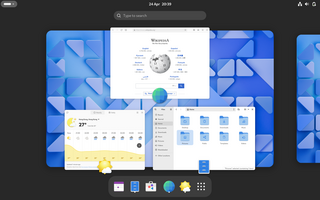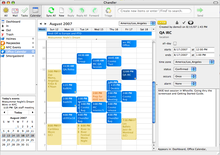Camunda Platform is a free and open workflow and decision automation platform. Camunda Platform ships with tools for creating workflow and decision models, operating deployed models in production, and allowing users to execute workflow tasks assigned to them. It is developed in Java and released as source-available software; the Desktop Modeler is licensed under the MIT License, other components under proprietary licenses.
Lotus Software was an American software company based in Massachusetts; it was "offloaded" to India's HCL Technologies in 2018.

Open-source software (OSS) is computer software that is released under a license in which the copyright holder grants users the rights to use, study, change, and distribute the software and its source code to anyone and for any purpose. Open-source software may be developed in a collaborative public manner. Open-source software is a prominent example of open collaboration, meaning any capable user is able to participate online in development, making the number of possible contributors indefinite. The ability to examine the code facilitates public trust in the software.
An application program is a computer program designed to carry out a specific task other than one relating to the operation of the computer itself, typically to be used by end-users. Word processors, media players, and accounting software are examples. The collective noun "application software" refers to all applications collectively. The other principal classifications of software are system software, relating to the operation of the computer, and utility software ("utilities").
The Open Source Applications Foundation (OSAF) was a non-profit organization founded in 2002 by Mitch Kapor whose purpose was to effect widespread adoption of free software/open-source software.
eZ Publish is an open-source enterprise PHP content management system that was developed by the Norwegian company Ibexa. eZ Publish is freely available under the GNU GPL version 2 license, as well as under proprietary licenses that include commercial support. In 2015, eZ Systems introduced eZ Platform to replace eZ Publish with a more modern and future-proof solution.

Kontact is a personal information manager and groupware software suite developed by KDE. It supports calendars, contacts, notes, to-do lists, news, and email. It offers a number of inter-changeable graphical UIs all built on top of a common core.

ArcGIS is a family of client, server and online geographic information system (GIS) software developed and maintained by Esri. ArcGIS was first released in 1999 and originally was released as ARC/INFO, a command line based GIS system for manipulating data. ARC/INFO was later merged into ArcGIS Desktop, which was eventually superseded by ArcGIS Pro in 2015. ArcGIS Pro works in 2D and 3D for cartography and visualization, and includes artificial Intelligence (AI).
Agenda is a DOS-based personal information manager, designed by Mitch Kapor, Ed Belove and Jerry Kaplan, and marketed by Lotus Software.
Haystack is a project at the Massachusetts Institute of Technology to research and develop several applications around personal information management and the Semantic Web. The most notable of those applications is the Haystack client, a research personal information manager (PIM) and one of the first to be based on semantic desktop technologies. The Haystack client is published as open source software under the BSD license.

Apache Taverna was an open source software tool for designing and executing workflows, initially created by the myGrid project under the name Taverna Workbench, then a project under the Apache incubator. Taverna allowed users to integrate many different software components, including WSDL SOAP or REST Web services, such as those provided by the National Center for Biotechnology Information, the European Bioinformatics Institute, the DNA Databank of Japan (DDBJ), SoapLab, BioMOBY and EMBOSS. The set of available services was not finite and users could import new service descriptions into the Taverna Workbench.

Silverstripe CMS is a free and open source content management system (CMS) and framework for creating and maintaining websites and web applications. It provides an out of the box web-based administration panel that enables users to make modifications to parts of the website, which includes a WYSIWYG website editor. The core of the software is Silverstripe Framework, a PHP Web application framework.

GNOME, originally an acronym for GNU Network Object Model Environment, is a free and open-source desktop environment for Linux and other Unix-like operating systems.

Apache OpenOffice (AOO) is an open-source office productivity software suite. It is one of the successor projects of OpenOffice.org and the designated successor of IBM Lotus Symphony. It is a close cousin of LibreOffice, Collabora Online and NeoOffice. It contains a word processor (Writer), a spreadsheet (Calc), a presentation application (Impress), a drawing application (Draw), a formula editor (Math), and a database management application (Base).

iDempiere. Community Powered Enterprise, also known as OSGi + ADempiere, is an open source Enterprise Resource Planning (ERP) software that is fully navigable on PCs, tablets and smartphones, it also has customer relationship management (CRM) and supply chain management (SCM) functions. It is in contrast to proprietary or most other open source ERP solutions driven only by a community of supporters.
Imixs Workflow is an Open-Source-Project, providing technologies for building Business Process Management solutions. The project focus on human based workflows used to execute and control workflows in organisations and enterprises. In difference to task-oriented workflow engines, which focus on automated program flow control (tasks), Imixs Workflow is a representative of an event-based workflow engine. Here, the engine controls the status of a process instance within a defined state-diagram. By entering an event, the state of a process instance can be abandoned or changed. In human-centric workflow engines, events usually occur by an interaction of the actor with the system, for example by approving or rejecting a business transaction. They can also be triggered by scheduled events. An example of this is an escalation of an unfinished task.

Apache Airflow is an open-source workflow management platform for data engineering pipelines. It started at Airbnb in October 2014 as a solution to manage the company's increasingly complex workflows. Creating Airflow allowed Airbnb to programmatically author and schedule their workflows and monitor them via the built-in Airflow user interface. From the beginning, the project was made open source, becoming an Apache Incubator project in March 2016 and a top-level Apache Software Foundation project in January 2019.








